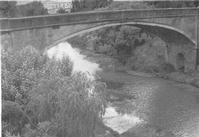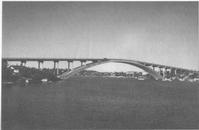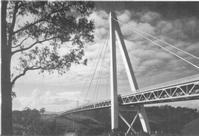


Chapter 6
I Construction During The Settlement Years
II The Use Of Timber As A Structural Material
III Structural Steel
IV Concrete Technology
V Housing
VI Industrialised Pre-cast Concrete Housing
VII Ports And Harbours
VIII Roads
IX Heavy Foundations
X Bridges
XI Sewerage
XII Water Engineering
XIII Railways
XIV Major Buildings
XV Airports
XVI Thermal Power Stations
XVII Materials Handling
XVIII Oil Industry
XIX The Snowy Mountains Scheme
XX The Sydney Opera House
XXI The Sydney Harbour Bridge
XXII Hamersley Iron
XXIII North West Shelf
Sources and References
Index
Search
Help
Contact us

With the start of the twentieth century, however, three important factors came to bear on Australian bridge design -the advent of concrete and steel, and the emergence of scientific design. These factors enabled much more efficient bridges to be built and the local production of these materials freed the designer from the limitations imposed by masonry (brick and stone) and the need to import iron. One of the world's first reinforced concrete girder bridges was the Lamington bridge at Maryborough, Queensland, opened in 1896 and designed by A. P. Brady. Other early concrete bridges include those built by Monash and Anderson in Victoria, such as the Morell bridge in Melbourne built in 1899 and the Fyansford bridge in Geelong (Fig. 28), built in 1900.

At this stage in Australia's history, most of the expansion associated with the boom years had already taken place and bridge building was concentrated on consolidation and improving the transport networks within the cities. During this period the technology of riveted steel bridges was developed, mainly in the form of the plate girder. Few bridges on a grand scale were needed, although an exception to this, and perhaps the climax of riveted steel construction, was the building of the Sydney Harbour bridge (see p. 427). This was completed in 1932 and at the time was the longest steel arch bridge in the world. At this stage concrete bridges were not economically competitive with steel in this range and because of their large dead weight, the strength limitations of reinforced concrete and the requirements for falsework, they were confined to shorter span structures.
In the post-war years of the 1950s and 1960s the rapid increase in road vehicle usage and city expansion again put pressure on the transport network. The building of bridges in areas previously neglected as too difficult was now demanded by the transport planners. Structures were required to cross large areas of water, often requiring these stretches to remain navigable to large ships so that large spans and high clearances were required. This challenge went hand in hand with the development of pre-stressed concrete, which enabled this material, now becoming competitive in cost to steel, to be used in much larger spans and to also be built without falsework, which was previously one of the main advantages of steel. Also at this time there was an increasing awareness of bridge form within the landscape, be it rural or urban, and designers were required to produce environmentally sympathetic structures. Driving standards and safety required that the road alignment determined the bridge location and not vice versa.
Some of the notable and innovative bridges of this period include the Gladesville bridge in Sydney (Fig. 29), with its elegant concrete arch span; the Westgate bridge, Melbourne, which utilises cable-stayed steel box girder main spans and post-tensioned concrete box girder approaches; Batman bridge Tasmania (Fig. 30), the first cable-stayed bridge in Australia; the Merivale railway bridge, a striking modern steel tied arch span over the Brisbane River, and the Gateway bridge, Brisbane, being at its construction the largest balanced cantilever construction in concrete in the world.


People in Bright Sparcs - Anderson, J. T.; Brady, A. P.; Laurie, J. B.; Monash, Sir John
 |
Australian Academy of Technological Sciences and Engineering |  |
© 1988 Print Edition pages 357 - 359, Online Edition 2000
Published by Australian Science and Technology Heritage Centre, using the Web Academic Resource Publisher
http://www.austehc.unimelb.edu.au/tia/360.html